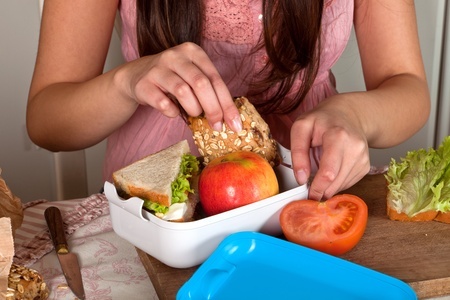
As a Registered Dietitian specializing in eating disorders, To the Bone, the Netflix movie about a young woman with anorexia nervosa, has been a recent hot topic among my eating disorder colleagues and in my sessions with clients. Lead actress, Lily Collins, and writer/director Marti Noxon, have both been open about their personal battles with eating disorders and have promoted their movie as a way to spark important conversations about these serious illnesses.
I completely agree that we need to be talking about eating disorders more, and if the media buzz and ongoing commentaries about To the Bone are any indication, this movie has accomplished that goal. But is starting a dialogue about eating disorders a good enough outcome to justify the potential harm this movie may cause?
Whatever positive intentions may have been behind To the Bone, it fails both as a film made purely for entertainment purposes, and certainly as an eating disorder advocacy piece. I agree with the criticism that this film perpetuates stereotypes about eating disorders. It often felt like the writers had a checklist of eating disorder symptoms and behaviors they arbitrarily ticked off to try to bring authenticity to the story (Lanugo – check. Chewing and spitting – check. Body checking – check.), but it didn’t work.
My concern with To the Bone is that the graphic depictions of eating disorder behaviors and close up shots of the lead character’s extremely thin body may be harmful to those currently dealing with an eating disorder and those at risk of developing an eating disorder. But more importantly, I strongly disagree with many of the messages in this movie, including:
You have to hit “rock bottom” before you will recover. With eating disorders, rock bottom can mean irreversible medical complications, including death. Eating disorders are serious, but treatable conditions. The goal is to intervene as soon as possible before severe consequences occur because the sooner a person gets treatment, the better the chance of recovery. The last thing we want is for anyone to think they aren’t sick enough to seek help.
You have to be fully ready to recover for treatment to work. Ambivalence about recovery is extremely common. Many of my clients don’t feel completely ready for recovery when they start treatment – and that’s ok! Part of them wants to recover, and part doesn’t. Part of them recognizes the negative impact of their eating disorder, while another part isn’t ready to give it up. Especially in the early stages of recovery, when malnutrition makes it hard to think rationally or see the effects of the eating disorder clearly, the healthy voice that wants to get better may barely be a whisper. But that’s no reason to delay getting help.
You’ll be able to eat in a way that supports recovery without any guidance or supervision. The patients in the treatment facility in this movie are seemingly on their own to decide what to eat, how much to eat, and even if they will eat. The group meals are completely unsupervised and there are more eating disorder behaviors around the table than there are people (one patient eats peanut butter straight from the jar for dinner, while another pushes a couple eggs around her plate for most of the meal, etc.). I don’t know of any treatment center that would advocate this approach because nutrition is such a key part of recovery. Learning to eat in a way that provides adequate energy and nutrients for healing while challenging the food rules and rigidity of an eating disorder doesn’t happen spontaneously – it requires specific guidance, support, monitoring, and healthy role modeling from a dietitian and the rest of the treatment team.
It’s possible to lose weight and become underweight in a healthy way. There’s been a lot of criticism about Lily Collins’ weight loss for this role, which she’s defended by saying it was done “safely” under the guidance of a nutritionist and was necessary to tell this story (I’d love to know who that nutritionist is! I’ll bet it wasn’t an eating disorder specialist!). First of all, having an emaciated body is not mandatory to portray someone struggling with an eating disorder. There are many women with serious eating disorders that don’t appear obviously underweight (even though they are at too low of a weight for their body). Even if the actress or director felt this character needed to look underweight, wonders can be done with makeup, wardrobe, and special effects. Bottom line: Losing weight to become underweight CANNOT be done in a healthy way. More importantly, weight loss is a major trigger for relapse from an eating disorder, making it both unhealthy and unsafe for Ms. Collins.
Spreading inaccurate and potentially harmful messages like these is irresponsible, particularly for a film that claims to want to help those with eating disorders. So when clients ask me if I think they should see To the Bone, my answer is NO because this movie is unlikely to help in their recovery and it is likely to be extremely triggering.
 Dancers are artistic athletes. They need the strength and energy to meet the physical demands of training and performing and they also need to maintain the aesthetic requirements of their art. Figuring out the best way to eat to achieve both can be challenging. And unfortunately, the pressures of the profession, the abundance of misinformation, the influence of fellow dancers, and the lure of the magical quick-fix can lead to following a diet that is more harmful than healthy.
Dancers are artistic athletes. They need the strength and energy to meet the physical demands of training and performing and they also need to maintain the aesthetic requirements of their art. Figuring out the best way to eat to achieve both can be challenging. And unfortunately, the pressures of the profession, the abundance of misinformation, the influence of fellow dancers, and the lure of the magical quick-fix can lead to following a diet that is more harmful than healthy. It’s National Eating Disorders Awareness Week, and this year’s theme, “I Had No Idea,” focuses on raising awareness about the possible triggers and warning signs of eating disorders. Being able to recognize these signs, symptoms, and contributing factors makes early intervention possible and can prevent a full-blown eating disorder from developing. Early detection and intervention also increases the chances of full recovery.
It’s National Eating Disorders Awareness Week, and this year’s theme, “I Had No Idea,” focuses on raising awareness about the possible triggers and warning signs of eating disorders. Being able to recognize these signs, symptoms, and contributing factors makes early intervention possible and can prevent a full-blown eating disorder from developing. Early detection and intervention also increases the chances of full recovery. Have you ever missed lunch because you didn’t have time to run out and grab a meal? Then you know firsthand that delaying or skipping meals leaves you feeling ravenous. Being overly hungry can decrease focus and productivity and increase irritability and stress. That’s no fun for anyone!
Have you ever missed lunch because you didn’t have time to run out and grab a meal? Then you know firsthand that delaying or skipping meals leaves you feeling ravenous. Being overly hungry can decrease focus and productivity and increase irritability and stress. That’s no fun for anyone!


